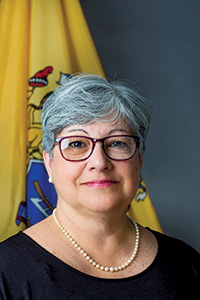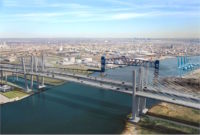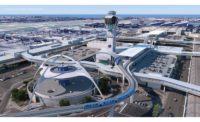No public agency with “DOT” as part of its acronym has it easy, regardless of size or geography. But consider the complicated milieu that the New Jersey Dept. of Transportation faces in its infrastructure management responsibilities.
Packed within the borders of the nation’s fourth-smallest state are more than 2.3 million miles of agency-managed roads and bridges. They connect the nation’s first- and fifth-largest metropolitan areas, New York City and Philadelphia, as well as most other destinations along the Eastern Seaboard and points west. Farmers and industries are as dependent on NJDOT’s infrastructure as commuters and vacationers, with many corridors in near constant use. And all of them must be maintained, rebuilt and expanded against a yearly cycle of weather extremes ranging from multiple doses of snow and ice and asphalt-buckling heat to surges from major Atlantic storms. According to Dodge Data & Analytics, the department started on projects worth $614.7 million in 2017.
 |
| Bell Road Bridge over I-295 in Camden County is part of the $900-million Direction Connection program, whose Contract 3 was awarded in 2017. PHOTO COURTESY OF NJDOT |
Many of these challenges aren’t unique to New Jersey, “but with all due respect to other states, [NJDOT’s] job is more difficult than most others,” says former agency assistant commissioner Anthony Attanasio, who now serves as executive director of the state’s Utility and Transportation Contractors Association.
A similar kind of perseverance has helped NJDOT weather other problems, like being a political football in the state’s recent pitched budget skirmishes. The agency won the battle for funding reliability through a 23-cent fuel tax increase in 2016 that will provide $2 billion for the state Transportation Trust Fund through fiscal year 2024. But it could still lose the war in carrying out its multifaceted mission. NJDOT’s decade-long hiring and wage freeze has cost the agency hundreds of employees—and their decades of experience.
Uncertainties over the future of federal government support for the Northeast’s infrastructure raises questions about how far those newfound Transportation Trust Fund dollars can go. The money could even become a double-edged sword. Joe Fiordallso, president of the American Council of Engineering Cos. of New Jersey, notes that while the program should help get more new projects into the pipeline, “the public, legislators and stakeholders will have higher expectations” about the department’s efficiency in managing projects.
Newly elected Gov. Phil Murphy, a Democrat who succeeded two-term Republican Chris Christie in the 2017 off-year election, opted for a homegrown approach to deal with these complex issues. In December, he tapped Newark-born Diane Gutierrez-Scaccetti as transportation commissioner, bringing the former N.J. Turnpike Authority executive director back to the Garden State following her six-year stint heading Florida’s 483-mile turnpike system.
Gutierrez-Scacetti’s appointment, which is pending approval of the state Senate, has drawn wide praise from the industry. “Diane is an experienced transportation executive who appreciates the symbiotic relationship between the agencies and the industry,” says Attanasio, who worked with her on Murphy’s transportation and infrastructure transition team. “We believe she will be an excellent commissioner of transportation.”
Don DiZuzio, senior vice president and transportation practice leader for T&M Associates, Middletown, N.J., shares that enthusiasm, citing Gutierrez-Scacetti’s success building a team environment at the Florida Turnpike Authority. “We hope she can do the same at NJDOT,” he says.
Strong starting point
 |
| Diane Guiterrez- Scaccetti, who impressed the industry in a previous role heading the N.J. Turnpike Authority, was appointed New Jersey’s transportation commissioner in January. She awaits legislative confirmation. PHOTOS COURTESY OF NJDOT |
Gutierrez-Scaccetti has publicly acknowledged her tough mission ahead, which includes overseeing both NJDOT and NJ Transit. The country’s third-largest provider of bus, rail and light rail transit by ridership, NJ Transit now faces key financial, management and construction challenges, particularly mandated completion of positive train control installation by the year’s end. Murphy was noncommittal in a March CBS news interview about whether the deadline will be met or if the system will gain an extension. But he noted a $242-million state boost for NJ Transit in fiscal 2019.
Fiordallso notes that NJDOT has made good progress in recent years on the “state of good repair” front, reducing the number of structurally deficient bridges and beefing up deteriorated pavement statewide.
And many of the agency’s projects are hardly routine or lacking for new ideas. The $920-million Direct Connection program to untangle the I-295/State Route 42/I-76 interchange in Camden County reached another milestone with the award of the $192.2-million Contract 3 to South State Inc. That project calls for completing the I-295 mainline Direct Connection ramp over Route 42/I-76, working on an adjacent road overpass and building ramps to Route 42. Its fourth and final contract is scheduled to get underway in 2019.
Then there’s the $480-million Wittpenn Bridge replacement in Jersey City, which includes installation of the state’s first orthotropic steel deck for the new elevated vertical lift structure spanning the Hackensack River. Lighter and stronger than conventional designs, the lift section should be easier to operate and require less maintenance. While construction won’t finish until about 2021, NJDOT seems particularly proud of Wittpenn—adding a website feature last summer for infrastructure enthusiasts to follow the deck in real time as it traveled from prefabrication in Washington state through the Panama Canal to the Garden State.
The oldest structure in NJDOT’s inventory, the Stone Arch Bridge over Stoney Brook in Princeton, also received a makeover in 2017. Built in 1792 and widened in 1916, the historic triple-arch structure was closed for more than a year following a partial parapet collapse. South State Inc. rehabilitated it, then reapplied as many original stones as possible to restore its historic look.
NJDOT has no shortage of other bridge projects on tap for 2018. Work is underway on a new $90.3-million rehabilitation of the nine-span I-495 Bridge over Route 1/9 and Paterson Plank Road in North Bergen, a key connector to the Lincoln Tunnel. I.E.W. Construction Group Inc., Trenton, is handling the multistage project that includes repair and reconstruction of the 80-year-old bridge deck, replacement and strengthening of deteriorated structural steel and substructure repairs.
Construction is also set to resume on the long-stalled $53-million Route 206 bypass in Hillsborough, which has languished for lack of funding since the initial 1.7-mile segment of the four-mile project was finished in 2013.
And despite the focus on major traffic corridors, the state’s communities haven’t been overlooked. The $161 million in NJDOT-funded municipal aid grants in 2018 for road and bridge fixes is the largest such distribution in state history.
NJDOT has also adopted innovative approaches such as accelerated bridge construction (ABC) to tackle space-constrained structural replacements. Last summer, J.F. Creamer and Son LLC and Sanzari Inc. used ABC to replace the Route 1/9 bridge over Jones Road in Bergen County. The $4.3-million project was timed to minimize traffic disruptions for both Manhattan-bound commuters and students at a nearby school. ABC has also helped expedite the $56.4-million phased replacement of the Mathis and Tunney bridges over Barnegat Bay, helping to compress the complex project into three limited construction seasons to minimize impacts to shore-bound motorists.
Having to manage infrastructure in close confines has also helped make NJDOT a national leader in the use of drones.
Among the department’s initiatives is inspecting more than 240 high-mast light poles. Drones afford a close-up view of the entire pole, including providing high-definition photos, and they are both economical and less disruptive to traffic. Other drone applications now being explored by the agency include construction monitoring and 3D corridor mapping and modeling.
Cultural restoration
As Gutierrez-Scaccetti settles into her Trenton office, revitalizing NJDOT is among her highest priorities. She recently told NJ Business magazine that state transportation agency employees “are hungry to do their jobs,” and that it’s on her to provide the needed tools, otherwise “that shortcoming falls on me.”
DiZuzio would like to see legislation authorizing the agency to use nonconventional project delivery methods such as design-build and public-private partnerships. “This is an ideal time to start looking at ways to do things differently and get more projects out,” he says.
 |
| The Wittpenn Bridge replacement project is expected to wrap up in 2021. PHOTO COURTESY NJDOT |
The time is likewise right, says Fiordallso, to take a hard look at New Jersey’s transportation future. “Planning functions have essentially been mothballed,” he says, “with no long-term message about what we’ll need when it comes to things like autonomous vehicles and connections to other modes. I’m hopeful that under this administration, we’ll start to see that.”
Gutierrez-Scaccetti has already demonstrated a willingness to embrace the future. David Mulholland, southeast regional manager for East Coast transportation engineering firm VHB, credits Gutierrez-Scaccetti for helping direct “the advancement of the future vision of the next wave of transportation” in Florida. While at the helm of the state’s turnpike system, she was instrumental in establishing and advancing the SunTrax AV test track in Orlando, one of 10 federally designated proving grounds nationwide.
Attanasio believes that rebuilding agency relationships with the engineering and construction sector will be essential to any goals the new administration hopes to achieve. “To have a strong industry, you need a strong owner,” he says, citing the legacy of NJDOT-industry collaboration that helped overcome dire infrastructure challenges, such as the one-two punch of 2011’s scour-induced collapse of I-287 into the Rockaway River and Superstorm Sandy the following year. Extreme examples to be sure, Attanasio admits, “but they show how agency and industry can work together to get things done.”








Post a comment to this article
Report Abusive Comment